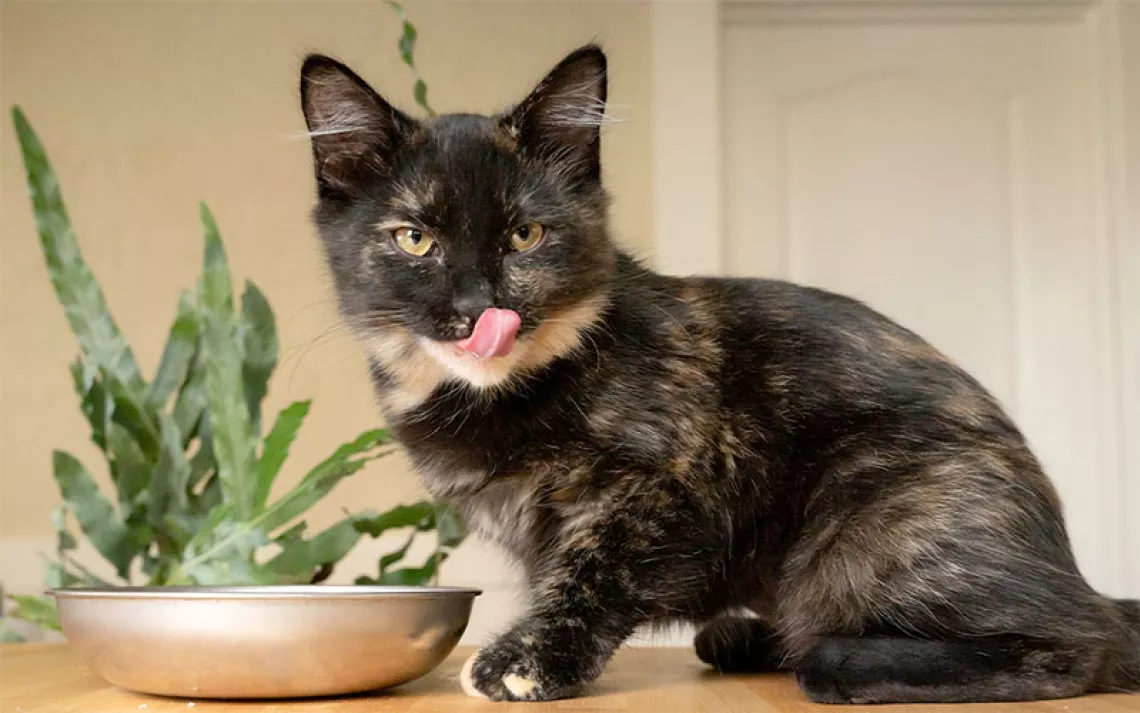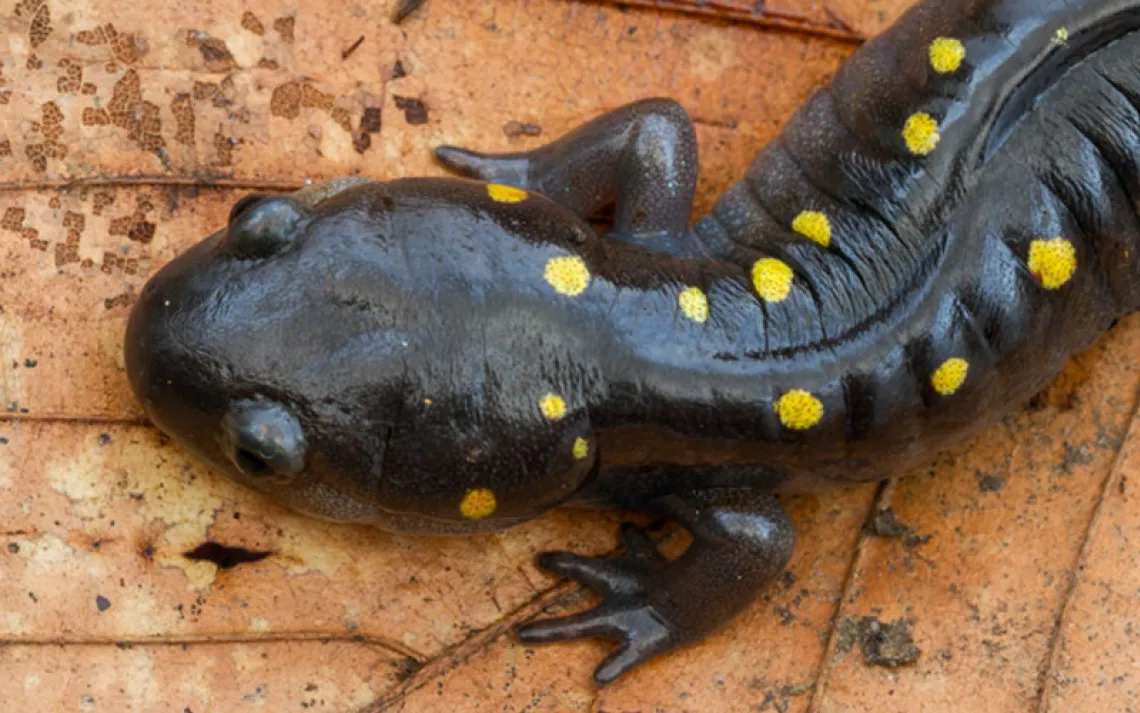Endangered Gibbons and the Village That Loves Them
For generations, the Garo people of Selbalgre have learned about sustainability from their friends in the forest

A male western hoolock gibbon peers from the trees on the outskirts of Selbalgre village in the Indian state of Meghalaya. | Photo by Anne Pinto Rodrigues
It is early morning in Selbalgre, a small village nestled in the forest-covered West Garo hills of Meghalaya, a state in northeast India. I am on my way to breakfast at the home of Wisdom Do.kongsi Momin, a community facilitator, but am stopped in my tracks by the energetic hoots reverberating through the cool air. “Oh-hoo, oh-hoo, oh-hoo, hoo, hoo, hoo. . .” As we climb a hill to reach Momin’s home, barely a mile from the old-growth forest protected by the community, the calls get nearer and louder.
The hoots are those of the western hoolock gibbon (Hoolock hoolock), the only ape found in India. The villagers call the gibbon huro. “They are precious to us,” says Momin affectionately, speaking in the A.chik dialect of the Garo language (translated by my local friend Rimchi Nokrek Marak). “In a family, children are the spark of the home. In the same way, they are the spark in our community,” Momin says. “Each morning, their calls energize us.”
For generations, the 800-some villagers in Selbalgre, members of the Garo ethnic group, have been protecting these gibbons and their home in the community forest, well before formal conservation programs began here in the 1990s. In 2007, Selbalgre’s leaders took the initiative of declaring the entire village, along with the community forest, as a gibbon reserve. Fewer than 5,000 western hoolock gibbons—also known as the white-browed gibbon, with reference to its distinctive eyebrows—remain across its range in northeast India, eastern Bangladesh, and Myanmar. IUCN lists the species as endangered, and it was included in the 2006–2008 World's 25 Most Endangered Primates list.
Back at Momin’s home, a few others have gathered in the courtyard to share their stories of living with these wild gibbons. They are all farmers growing rice, millets, a variety of green vegetables and tubers, on hillsides using shifting cultivation. In their home gardens, they grow several fruits like pineapple, oranges, pomelos, and bananas. Momin’s wife, Enjine Chambugong Marak, steps out carrying the breakfast tray, loaded with cups of piping-hot ginger tea and small banana leaf parcels containing individual portions of steamed or fried cassava.
“We have seen huro since childhood. We have grown up with them,” says Sahen Chambugong Marak. “As children, our elders told us not to kill them, not to chase them, or harm them in any way. Even though the elders converted to Christianity, they believed that harming the huro will invoke a curse on the village from the gods,” says Marak. “Soil fertility and food production will decrease.”
The villagers’ beliefs linking gibbons to soil fertility and food production possibly stem from their observations over the ages, as the frugivorous (i.e., mostly fruit-eating) gibbons are important seed dispersers. “We believe that if the gibbons are there, then food production will be good,” Marak adds.
Selbalgre’s residents are extremely tolerant of the gibbons feeding in their fruit trees. “They only pluck the fruit they need, just one or two. They are not wasteful, like monkeys,” says Momin. “They teach us about sustainability, to take only what we need. We learn a lot from the gibbons.”
For example, says Obal Chambugong Marak, “When someone in the village passes away, [the gibbons] understand that we are grieving and they grieve with us. At those times, their call is different. It is slower and longer.” He proceeds to imitate the gibbon’s mourning call. The gibbons are also valued as protectors or guardians. “At night, if there is a large carnivore like a tiger passing by, they give us a warning,” says Mingjin Chambugong Marak, age 70.
Akem Chambugong Marak lists the many roles played by the gibbons in the community: “Rodilgipa [guardian], songdongdilgipa [teacher or adviser], cha.dilgipa [friend]. They entertain and comfort us. Their calls make us happy.”’
There are four gibbon families around the village, consisting of the parents—who mostly pair for life—and one or two offspring. The families stay in their own territories and do not venture outside it.
After breakfast, Momin conducts a small ritual to keep evil forces at bay and then leads us into the community’s sacred grove. Hours of walking up and down hills and through thick vegetation, wading across a rocky-bottom stream, and tracking the gibbon calls do not result in any sightings. Tired and disappointed, we begin our return.
Just as we are about to enter the village, we first sense and then see a pair of round brown eyes staring down at us from the tree canopy at the periphery. A male gibbon makes eye contact, while its mate and baby in tow peer warily from the foliage. For the next half hour, we watch this gibbon family sunbathe and relax, swinging from branch to branch using only their arms. The male is curious, stopping often to check us out before the family scurries off.
Beyond Selbalgre, the western hoolock gibbon is threatened by habitat loss and fragmentation, poaching, and the pet trade. Even here, outsiders occasionally dare to venture into the village to catch or hunt gibbons. So far, the huro’s human friends have been successful in stopping and fining the trespassers. In this tiny corner of India, gibbons and humans safeguard each other.
 The Magazine of The Sierra Club
The Magazine of The Sierra Club



